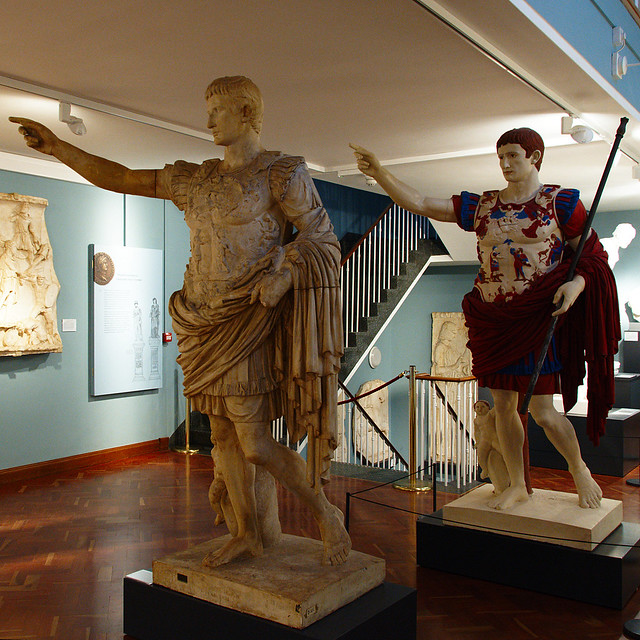The last section of the book I’m reading about Plantagenet England is about the society and people of the era. Prestwich starts the first chapter in this section by noting that whilst society was very stratified in this period the boundaries weren’t rigid and well defined (or least not in ways that historians can be sure of now). However, you can divide the society at this time into four rough groups – the great lords (both lay & church), the knights, the peasants and the merchants. This chapter deals with the first of those groups.
The Great Lords
The great lords were the higher nobility and there are a variety of phrases used in official documents of the time that can define them to one extent or another. The “prelates, earls and barons” is one, the “magnates and nobles” is another, or “earls, barons and magnates”. Also “magnates” can be used on its own. It’s easy to work out who the earls and the bishops are from the surviving documents, and they are well defined – it’s a specific title generally relating to a place.
The earls were the elite of the nobility. There were 30 titles during this period (1225-1360) not all of which were in existence for the whole time, and some individuals could hold multiple earldoms. This means there were very few earls at any one time – for instance in 1300 there were 9. The title itself was mostly honourific – they had few special duties and not much extra income from earldom related sources. Because of their status they had to attend the king when required, and were always summoned to parliament whenever it met. Some earldoms came with ceremonial duties (like carrying a particular sword during the coronation), some had military ranks attached (i.e. the earls of Norfolk and Hereford held the office of Marshal and of Constable during this period). So being an earl was mostly about status – one of the things that so annoyed the earls about Gaveston was his habit of giving rude nicknames to (other) earls. So rather than talking about (the earl of) Lincoln he would refer to “Burstbelly”.
Earls were wealthy – newly created earls were generally granted lands worth around 1,000 marks/year, which gives a feel for the minimum appropriate wealth (1 mark is 2/3 of a £). The title of an earl (which he was referred to by) related to a specific county, but that wasn’t necessarily where the earl held most lands. They also had symbolic swords, granted along with the title. During the 14th Century they started to wear coronets, and they were permitted the most costly clothing (like cloth of gold trimmed in ermine). Generally they also made much of their heraldic symbols, and used them to decorate their possessions and clothing.
During this period there wasn’t much continuity in the various titles. If there was no direct male heir, the family name died out and the lands (and titles) would be divided amongst the female heirs. That wrinkle in how inheritance worked was something I’d not learnt before – primogeniture for sons, but divided for daughters. Prestwich looks at the statistics for earldoms being extinguished (no valid heirs) and comes to the conclusion that whilst there seems to be an unusually high number of sonless and childless families, that’s probably just by chance as it’s such a small sample group rather than due to any underlying cause. Prestwich also spends a couple of pages considering the royal attitude towards extinguishing and granting earldoms. Events in Henry III’s reign encouraged Edward I to be very conservative about creating new earldoms, and to be keen to control the power of those that existed. Edward II and Edward III had more need to create new earldoms, because they had family to provide for. It was also important for the King to have enough earls – being accompanied by several earls enhanced the prestige of the King’s court, particularly important on foreign trips. And there was a general policy of granting earldoms to those related by blood to the royal family, in the hope this would keep them loyal.
There’s not much in the sources about the countesses, but what there is tends to indicate that these high status & wealth women had some influence on the events of the day. Which is not surprising, but frustrating that we don’t know more about them. Prestwich talks about several notable women. Most of what is known about them revolves around their marriages, as you’d expect in chronicles from this era. But widows (of men with no heirs) could live out their lives as the landowner & head of their estates – and their power in this area was as much as any man’s, just they had much less power in politics.
Next down the social tree from earls were barons. Being a baron didn’t confer any rights or powers, rather it imposed some requirements on you (like paying a particular tax) so it wasn’t necessarily something people wanted. Barons did have a voice in parliament, which was formally recognised. For instance in the Ordinances of 1311 many matters were set down as requiring “the consent of the baronage”. Inconveniently for the later historian not all barons were summoned individually to parliament, so there aren’t complete lists surviving. The numbers who did get individual summons varied between a low point of around 30 to a high point of around 80. Generally Baron wasn’t used as a title, those who were barons tended to go by “Lord” and can be hard to distinguish from knights. As a result it’s difficult for the modern historian to be sure how many there were, or who exactly they were. Prestwich notes that one thorough survey (by a historian who published it in 1927) came up with 135 baronies, plus another 72 probables. So this is still a relatively small elite. Again the inheritance was by primogeniture for sons, but divided if there were only daughters – so sometimes baronies fractured into smaller pieces which may’ve all had the same baronial status. There was a reasonable amount of social mobility into the baronial class, with knights who distinguished themselves in battle or supported the right earl during a domestic conflict standing a chance of being granted lands that would confer that status.
Adjacent to the secular hierarchy was the clerical one. In the category of great lords we have the archbishops, the bishops and the greater abbots. Archbishops and bishops are well defined, but as with the barons the “greater abbots” are less clear. Not all of these men were of aristocratic birth, it was definitely possible to rise through the ranks as a clergyman. Bishoprics were often handed out as rewards to men who had held government posts. Some bishops were exceedingly wealthy, on a par with earls, others less so. The greater abbots were summoned to parliament, but otherwise their political role was relatively unimportant. Again they were often wealthy. The sources of the time judge abbots on their ability as manager of their monastic estates.
These great lords did not have a fixed address – the great lived in households which moved around between their various houses and court. The household comprised all the furnishing and so on that the lord moved with him, as well as his staff. Even a relatively low status member of the elite might have 25 staff in his household, spread throughout the various departments. This number doesn’t include any knights or men-at-arms who were retained, nor people like huntsmen or carters. A large household plus other employees for an important magnate might run to 200 or more. As well as the size of the household depending on the status of the lord, over the time period that this book covers there was a general increase in the size of the magnates’ households. Staff were generally provided with robes, and with food whilst at the household. They would also get wages, which might be paid by giving them the right to the rents from a particular estate.
Prestwich discusses in detail how this era had a mix of traditional feudalism and what’s known as “bastard feudalism”. In the first, the retainer holds lands from his lord and owes him service for them. In the latter, the retainer is rewarded for his service by cash (which may be rent from an estate). The two systems existed side by side during this period, and Prestwich is quite clear that he doesn’t see it as a transition from one system to another.
The castles and manor houses that these great lords built & lived in were overt expressions of their power. Although there weren’t any explicit restrictions on who could build a castle, it took wealth to do so. Generally the great lords built new fashionable residences when they could, but it wasn’t seen as necessary – more something to do when one could afford it. During this period residences were becoming more comfortable and less defensive, although it’s the military aspects that survive to the present day (being built from stone instead of wood).
The ceremonies surrounding death were another way for a magnate’s family to indicate their status. Elaborate funerals were important, as were ostentatious memorials (such as gravestones and monuments). Families tended to be buried in the same church for generations, although this could lead to arguments particularly in the case of women who had married more than once. Prestwich gives the example of Isabella (daughter of William Marshal) who married three times, and ended up with her body buried in Beaulieu, her heart in Tewkesbury and her entrails in Missenden. Other people worried about the anticipated bodily resurrection at the Last Judgement – sometimes a person was buried in multiple places, then later their body would be gathered back up by a relative to be reburied in one place. Also important for religious reasons was to provide money for services to be held after death, to ensure a short stay in Purgatory.
Prestwich ends the chapter by being a little scathing about anyone either contemporary or modern who tries to draw conclusions about “all the great lords”, because there’s too much variance between the individuals. The stereotype is of boneheaded brawlers, and some do fit this characterisation. Others don’t, in a variety of ways.





